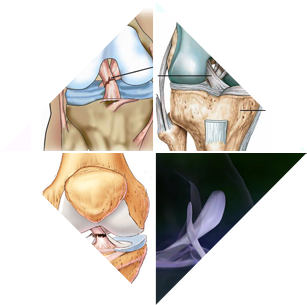
Anterior Cruciate Ligament (ACL)
Surgery for Anterior Cruciate Ligament (ACL) involves
reconstructing or repairing theACL.ACL reconstruction surgery
uses a graft to replace the ligament. The most common grafts are
autografts using part of your own body, such as the tendon of
the kneecap (patellar tendon) or one of the hamstring tendons.
Another choice is allograft tissue, which is taken from a
deceased donor. Repair surgery typically is used only in the
case of an avulsion fracture (a separation of the ligament and a
piece of the bone from the rest of the bone). In this case, the
bone fragment connected to the ACL is reattached to the bone.
ACL surgery is usually done by making small incisions in the
knee and inserting instruments for surgery through these
incisions (arthroscopic surgery). In some cases, it is done by
cutting a large incision in the knee (open surgery).
ACL surgeries are done by orthopedic surgeons.
Knee arthroscopic surgery
Definition
Knee arthroscopic surgery is a procedure performed through small
incisions in the skin to repair injuries to tissues such as
ligaments, cartilage, or bone within the knee joint area. The
surgery is conducted with the aid of an arthroscope, which is a
very small instrument guided by a lighted scope attached to a
television monitor. Other instruments are inserted through three
incisions around the knee. Arthroscopic surgeries range from
minor procedures such as flushing or smoothing out bone surfaces
or tissue fragments (lavage and debridement) associated with
osteoarthritis, to the realignment of a dislocated knee and
ligament grafting surgeries. The range of surgeries represents
very different procedures, risks, and aftercare requirements.
While the clear advantages of arthroscopic surgery lie in
surgery with less anesthetic, less cutting, and less recovery
time, this surgery nonetheless requires a very thorough
examination of the causes of knee injury or pain prior to a
decision for surgery.
Purpose
There are many procedures that currently fall under the general
surgical category of knee arthroscopy. They fall into roughly
two groups—acute injuries that destabilize the knee, and pain
management for floating or displaced cartilage and rough bone.
Acute injuries are usually the result of traumatic injury to the
knee tissues such as ligaments and cartilage through accidents,
sports movements, and some overuse causes. Acute injuries
involve damage to the mechanical features, including ligaments
and patella of the knee. These injuries can result in knee
instability, severe knee dislocations, and complete lack of knee
mobility. Ligament, tendon, and patella placements are key
elements of the surgery. The type of treatment for acute
injuries depends in large part on a strict grading system that
rates the injury. For instance, grades I and II call for rest,
support by crutches or leg brace, pain management, and
rehabilitation. Grades III and IV indicate the need for surgery.
Acute injuries to the four stabilizing ligaments of the knee
joint—the anterior cruciate ligament (ACL), the posterior
cruciate ligament (PCL), the medial collateral ligament (MCL),
and the lateral collateral ligament (LCL)—as well as to the
"tracking," or seating of the patella, can be highly
debilitating.
more information

